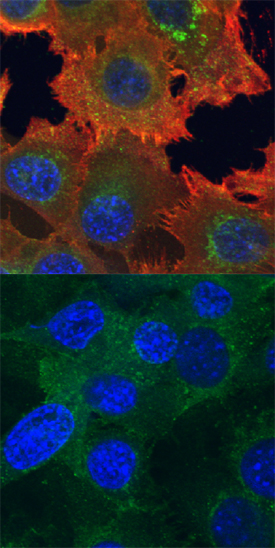Human Phospho-Axl (Y779) Antibody Summary
Applications
Please Note: Optimal dilutions should be determined by each laboratory for each application. General Protocols are available in the Technical Information section on our website.
Scientific Data
 View Larger
View Larger
Detection of Human Phospho-Axl (Y779) by Western Blot. Western blot shows lysates of A172 human glioblastoma cell line untreated (-) or treated (+) with 1 mM Pervanadate (PV) for 30 minutes. PVDF membrane was probed with 0.2 µg/mL of Mouse Anti-Human Phospho-Axl (Y779) Monoclonal Antibody (Catalog # MAB6965) followed by HRP-conjugated Anti-Mouse IgG Secondary Antibody (Catalog # HAF007). A specific band was detected for Phospho-Axl (Y779) at approximately 140 kDa (as indicated). This experiment was conducted under reducing conditions and using Immunoblot Buffer Group 1.
 View Larger
View Larger
Phospho-Axl (Y779) in A172 Human Cell Line. Axl phosphorylated at Y779 and total Axl were assessed in immersion fixed A172 human glioblastoma cells incubated with (upper panel) or without (lower panel) the phosphatase inhibitor pervanadate at 100 µM for 5 minutes. Phospho-Axl was detected using Mouse Anti-Human Phospho-Axl (Y779) Monoclonal Antibody (Catalog # MAB6965) at 10 µg/mL for 3 hours at room temperature. Cells were stained using the NorthernLights™ 557-conjugated Anti-Mouse IgG Secondary Antibody (red; Catalog # NL007) and counterstained using DAPI (blue). Total Axl was detected using Goat Anti-Human Axl Antigen Affinity-purified Polyclonal Antibody (Catalog # AF154). Cells were stained using the NorthernLights™ 493-conjugated Anti-Goat IgG Secondary Antibody (green; Catalog # NL003). Specific staining was localized to cytoplasm and cell surfaces. View our protocol for Fluorescent ICC Staining of Cells on Coverslips.
 View Larger
View Larger
Detection of Phospho-Axl (Y779) in A172 Human Cell Line by Flow Cytometry. A172 human glioblastoma cell line was unstimulated (open histogram) or treated with 100 µM pervanadate for 5 minutes, then stained with Mouse Anti-Human Phospho-Axl (Y779) Monoclonal Antibody (Catalog # MAB6965, filled histo-gram), followed by Phycoerythrin-conjugated Anti-Mouse IgG Secondary Antibody (Catalog # F0102B). To facilitate intracellular staining, cells were fixed with paraformaldehyde and permeabilized with Triton® X-100.
 View Larger
View Larger
Detection of Human Phospho-Axl (Y779) by Simple WesternTM. Simple Western lane view shows lysates of A172 human glioblastoma cell line untreated (-) or treated (+) with 1 mM Pervanadate (PV) for 30 minutes, loaded at 0.2 mg/mL. A specific band was detected for Phospho-Axl (Y779) at approximately 150 kDa (as indicated) using 4 µg/mL of Mouse Anti-Human Phospho-Axl (Y779) Monoclonal Antibody (Catalog # MAB6965). This experiment was conducted under reducing conditions and using the 12-230 kDa separation system.*Non-specific interaction with the 230 kDa Simple Western standard may be seen with this antibody.
Reconstitution Calculator
Preparation and Storage
- 12 months from date of receipt, -20 to -70 °C as supplied.
- 1 month, 2 to 8 °C under sterile conditions after reconstitution.
- 6 months, -20 to -70 °C under sterile conditions after reconstitution.
Background: Axl
Axl (Ufo, Ark), Dtk (Sky, Tyro3, Rse, Brt), and Mer (human and mouse homologues of chicken c-Eyk) constitute a subfamily of the receptor tyrosine kinases (1, 2). The extracellular domains of these proteins contain two Ig-like motifs and two fibronectin type III motifs. This characteristic topology is also found in neural cell adhesion molecules and in receptor tyrosine phosphatases. The human Axl cDNA encodes an 887 amino acid (aa) precursor that includes an 18 aa signal sequence, a 426 aa extracellular domain, a 21 aa transmembrane segment, and a 422 aa cytoplasmic domain. The extracellular domains of human and mouse Axl share 81% aa sequence identity. A short alternately spliced form of human Axl is distinguished by a 9 aa deletion in the extracellular juxtamembrane region. These receptors bind the vitamin K‑dependent protein growth arrest specific gene 6 (Gas6) which is structurally related to the anticoagulation factor protein S. Binding of Gas6 induces receptor autophosphorylation and downstream signaling pathways that can lead to cell proliferation, migration, or the prevention of apoptosis (3). This family of tyrosine kinase receptors is involved in hematopoiesis, embryonic development, tumorigenesis, and regulation of testicular functions. Phosphorylation of Tyrosine 779 provides a docking site for p85 subunits of PI 3-Kinase (4).
- Yanagita, M. (2004) Curr. Opin. Nephrol. Hypertens. 13:465.
- Nagata, K. et al. (1996) J. Biol. Chem. 22:30022.
- Holland, S. et al. (2005) Canc. Res. 65:9294.
- Weinger, J.G. et al. (2008) J. Neurochem. 106:134.
Product Datasheets
Citations for Human Phospho-Axl (Y779) Antibody
R&D Systems personnel manually curate a database that contains references using R&D Systems products. The data collected includes not only links to publications in PubMed, but also provides information about sample types, species, and experimental conditions.
2
Citations: Showing 1 - 2
Filter your results:
Filter by:
-
Hematopoietic niche drives FLT3-ITD acute myeloid leukemia resistance to quizartinib via STAT5- and hypoxia- dependent up-regulation of AXL
Authors: PY Dumas, C Naudin, S Martin-Lan, B Izac, L Casetti, O Mansier, B Rousseau, A Artus, M Dufossée, A Giese, P Dubus, A Pigneux, V Praloran, A Bidet, A Villacrece, AV Guitart, N Milpied, O Kosmider, I Vigon, V Desplat, I Dusanter-F, JM Pasquet
Haematologica, 2019-03-28;0(0):.
Species: Human
Sample Types: Cell Lysates
Applications: Western Blot -
Gilteritinib, a FLT3/AXL inhibitor, shows antileukemic activity in mouse models of FLT3 mutated acute myeloid leukemia
Authors: M Mori, N Kaneko, Y Ueno, M Yamada, R Tanaka, R Saito, I Shimada, K Mori, S Kuromitsu
Invest New Drugs, 2017-05-17;0(0):.
Species: Human
Sample Types: Cell Lysates
Applications: Western Blot
FAQs
No product specific FAQs exist for this product, however you may
View all Antibody FAQsReviews for Human Phospho-Axl (Y779) Antibody
There are currently no reviews for this product. Be the first to review Human Phospho-Axl (Y779) Antibody and earn rewards!
Have you used Human Phospho-Axl (Y779) Antibody?
Submit a review and receive an Amazon gift card.
$25/€18/£15/$25CAN/¥75 Yuan/¥2500 Yen for a review with an image
$10/€7/£6/$10 CAD/¥70 Yuan/¥1110 Yen for a review without an image

